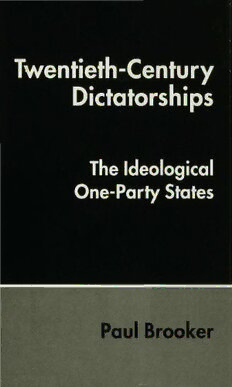
Twentieth Century Dictatorships: The Ideological One-Party States PDF
Preview Twentieth Century Dictatorships: The Ideological One-Party States
Twentieth-Century Dictatorships The Ideological One-Party States Paul Brooker TWENTIETH-CENTURY DICTATORSHIPS Also by Paul Brooker DEFIANT DICTATORSHIPS: Communist and Middle Eastern Dictatorships in a Democratic Age THE FACES OF FRATERNALISM: Nazi Germany, Fascist Italy, and Imperial Japan Twentieth-Century Dictatorships The Ideological One-Party States Paul Brooker Lecturer in Politics Victoria University of Wellington tt © Paul Brooker 1995 All rights reserved. No reproduction, copy or transmission of this publication may be made without written permission. No paragraph of this publication may be reproduced, copied or transmitted save with written permission or in accordance with the provisions of the Copyright, Designs and Patents Act 1988, or under the terms of any licence permitting limited copying issued by the Copyright Licensing Agency, 90 Tottenham Court Road, London W1P9HE. Any person who does any unauthorised act in relation to this publication may be liable to criminal prosecution and civil claims for damages. First published 1995 by MACMILLAN PRESS LTD Houndmills, Basingstoke, Hampshire RG21 2XS and London Companies and representatives throughout the world ISBN 0-333-61110-1 A catalogue record for this book is available from the British Library. 10 9 8 7 6 5 4 3 21 04 03 02 01 00 99 98 97 96 95 Printed and bound in Great Britain by Antony Rowe Ltd Chippenham, Wiltshire Contents Introduction 1 1 The Twentieth-Century Dictatorships' Challenge to Democracy 5 1 The Modernity of the New Form of Dictatorship 6 2 The Variety and Political Creativity of the Twentieth-Century Dictatorships 8 3 The Failure of the Challenge to Democracy: The Personalist Flaw 9 2 Analyzing the Ideological One-Party States: Components, Leadership and Types 14 1 Components 14 2 Individual/Collective Leadership and Personal Dictatorship 17 3 The Party-State and Military-Party Types 19 PART I THE PARTY-STATE TYPE 3 The Fascist Examples 23 1 Mussolini's Regime in Italy 23 2 Hitler's Regime in Germany 36 4 The Communist Regime in the Soviet Union from 1917 to 1945 51 1 Communist Ideology 52 2 The Communist Party 57 3 Lenin's Leadership of the Regime 66 4 Stalin's Rise to Personal Rule 68 5 The Party under Stalin's Leadership and then Personal Rule 77 5 A Survey of the Communist Regimes from the 1940s to 1980s 82 1 The Soviet Union after Stalin 82 v vi Contents 2 The East European Communist Regimes 85 3 Communism in Asia: China, Vietnam and North Korea 91 6 Third World Case Studies 99 1 Nkrumah's Ghana 99 2 Toure's Guinea 112 PART II THE MILITARY-PARTY TYPE 7 The Quasi-Fascist Examples 129 1 Primo de Rivera's Regime in Spain 129 2 Franco's Regime in Spain 138 8 Third World Socialist Case Studies 148 1 Nasser's Egypt 148 2 Ne Win's Burma 158 9 Third World 'Multi-Party' Case Studies 170 1 Peron's Argentina 170 2 Suharto's Indonesia 181 PART III TRANSFORMATIONS FROM ONE TYPE TO ANOTHER 10 From Party-State to Military-Party Regime 197 1 Kuomintang China 197 2 Communist Poland 210 11 From Military-Party to Party-State Regime 217 1 Post-Revolution Mexico 217 2 Castro's Cuba 231 12 From Party-State to Military-Party to Democratic Regime: Turkey since 1908 239 1 The Party-State Regime of the Committee of Union and Progress 240 2 The Shift to a Military-Party Regime under Kemal 242 3 From Personal Rule to Democracy 250 Contents vii Conclusion 254 Notes and References 257 Bibliography 294 Index 302 This page intentionally left blank Introduction As with many other political terms the meaning of * dicta torship' has changed markedly over the years. The origi nal meaning dates back to the ancient Roman office of Dictator, which conferred virtually unlimited powers on a temporary ruler installed by his fellow citizens to deal with an emergency. Nowadays any regime is likely to be called a dictatorship if it is neither a democracy nor one of the few remaining monarchies. Using this more recent and wider meaning of the term, it is easy to claim that the twentieth century has been the century of dictatorship. For certainly dictatorship has been the most common form of regime, much more common than democracy. However, one reason for there having been so many dicta torships is that most of them have been short-lived regimes. In fact often they claim, in a manner reminiscent of the older conception of dictatorship, to be intending to rule only tempo rarily. The military dictatorships are especially prone to present themselves in this fashion. They usually proclaim that the military have intervened in politics solely to save the nation and will return to the barracks as soon as possible. Such apparently temporary, emergency dictatorships are not really equivalents or rivals of any form of regime that, like monar chy and democracy, seeks to be a permanent fixture. But after the First World War there emerged a modernized form of dictatorship with a longer-term perspective than the previous forms. Although it would never be as numerous as the old-style dictatorships continued to be, the modern ized form of dictatorship became a real contender for the title of being the century's pre-eminent form of regime. Certainly it was the distinctively twentieth-century form of dictatorship, and its examples can be viewed as being in that sense the twentieth-century dictatorships. The characteristic feature of the modernized, twentieth-cen tury dictatorships was their possession of an official ideol ogy and political party. In some cases this involved simply an otherwise old-fashioned military dictatorship establishing 1
